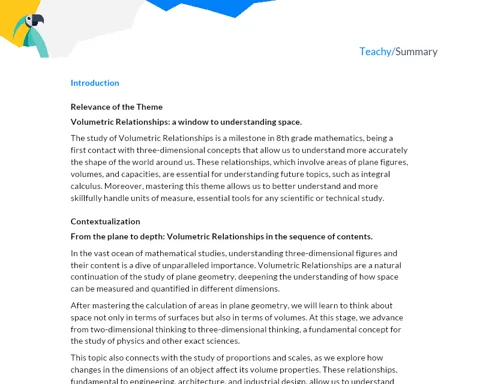INTRODUCTION
The Relevance of the Topic
- Measuring is Essential: Knowing how to measure is an important part of life. We use measurements to build, cook, and even travel.
- Understanding the World: Knowing measurement units helps to better understand space and time around us.
- Foundation for Advanced Mathematics: Measurements are the basis for learning more complex things in mathematics.
- Practical Skill: Measuring length and time is a skill used in people's daily lives.
Contextualization
- In the Curriculum: Measurements are part of the Mathematics curriculum from an early age, helping in the understanding of many other subjects.
- History of Measurements: People have been measuring things for a long time, using parts of the body, like the foot or the palm of the hand, until we reached standardized units.
- Connection with Other Disciplines: Length and time measurements connect mathematics with science, history, and geography.
- Growth and Curiosity: Learning about measurements stimulates intellectual growth and curiosity about how things work.
THEORETICAL DEVELOPMENT
Components
-
Length Measurement Units:
- Centimeter (cm): Used to measure small things, like a pencil.
- Meter (m): Basic unit of length. Think about the size of a door.
- Kilometer (km): For longer distances, like the one you travel from home to school.
- Ruler and Tape Measure: Tools we use to measure length. Ruler for smaller things, tape measure for larger things.
-
Time Measurement Units:
- Second (s): The time of a 'tick-tock' of a clock.
- Minute (min): There are 60 seconds. Time to sing a short song.
- Hour (h): 60 minutes. The time of a class.
- Clock and Stopwatch: Instruments to measure time. The clock shows the hours, the stopwatch counts the seconds.
Key Terms
- Measurement: Action of determining the quantity of something in terms of a unit of measurement.
- Standard: Reference used to avoid differences in measurements. For example, a meter is the same everywhere.
- Conversion: Changing a measurement to another (from meters to centimeters, for example).
Examples and Cases
-
Length Example:
- Scenario: Measuring the height of a plant.
- Action: Using a ruler and seeing how many centimeters it has.
- Theory: If the plant is 25 cm tall, it means it is 25 times the size of a standard centimeter.
-
Time Example:
- Scenario: How long does a race take.
- Action: Using a stopwatch and marking the time in minutes and seconds.
- Theory: If a race takes 2 minutes and 30 seconds, it means 150 seconds have passed since the start.
Remember, knowledge explorers: the world is full of things to measure, and understanding how we measure is like using a key to open a treasure chest! 🗝️💎
DETAILED SUMMARY
Relevant Points
- Importance of Measurements: Determining size or how time passes is fundamental in daily activities.
- Length Measurement Units:
- Centimeters: For smaller objects, like toys or books.
- Meters: Ideal for measuring larger objects, like the length of a table.
- Kilometers: Used for long distances, like the route taken by a car or bus.
- Length Measurement Instruments:
- Ruler: Common in classrooms, fits in a backpack, and great for smaller measurements.
- Tape Measure: Extendable, used to measure larger spaces, like a room or a soccer field.
- Time Measurement Units:
- Seconds: For quick moments, like the time to jump rope.
- Minutes: For slightly longer activities, like solving a puzzle or game.
- Hours: For extended periods, like the duration of a night's sleep.
- Time Measurement Instruments:
- Clock: For daily use, informs us of hours, minutes, and seconds.
- Stopwatch: Used to measure precise time intervals, like in sports competitions.
Conclusions
- Standardized Measurements: We use measurement systems accepted by all to avoid confusion.
- Conversion: It is possible to transform one measurement into another, such as from meters to centimeters, by multiplying or dividing.
- Practice: The more we use measurements in real life, the easier it becomes to understand and remember how to do it.
Exercises
- Measuring Objects:
- Take a ruler and measure three different objects in the classroom. Write down their measurements in centimeters.
- Measurement Conversion:
- If you have a tape measure that measures 200 centimeters, how many meters does it have? (Divide by 100 to convert.)
- Activity Time:
- Use a stopwatch to measure how long it takes you to draw a sun. Write down the time in minutes and seconds.
Remember, young everyday scientists: the right measure can take us far, and well-spent time is the secret to great discoveries! ⚖️⏰



